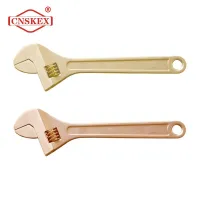Non-sparking safety tools are essential for operations in industries that work with flammable materials. These tools are made from non-ferrous metals, such as copper alloys or aluminum bronze, which minimize the risk of creating sparks. Sparks from standard tools can easily ignite volatile substances, making non-sparking tools crucial in specific settings. The tools help avoid mechanical friction or impact sparks that could otherwise lead to catastrophic explosions. For customers, the key question is: in which environments are these tools an absolute necessity?
To ensure workplace safety, non-sparking tools should be used in environments where hazardous conditions are present. The most common areas include:
Operations involving oil, gas, and petrochemical products typically require non-sparking tools. In these environments, flammable gases like methane and propane are abundant, creating a significant risk of explosions. Using non-sparking tools in such settings ensures that workers are not exposed to unnecessary hazards when performing routine tasks such as maintenance and repairs.
In chemical plants, workers deal with volatile chemicals and fumes that are often highly explosive. Non-sparking tools play a critical role in preventing accidental ignition when interacting with these dangerous substances. The right tools can help avoid incidents related to friction, impact, or static discharge.

Mining is another high-risk industry. In coal mining, for example, flammable gases such as methane are commonly found. Non-sparking tools are required to mitigate the potential for sparks during routine tasks. The use of proper tools not only helps in avoiding explosions but also ensures compliance with stringent safety standards in the mining sector.
Customers frequently raise concerns regarding the durability and costs associated with non-sparking tools, compared to standard tools. Here are answers to some common questions:
Non-sparking tools are softer than steel tools, which makes them more prone to wear and tear over time. While they may need to be replaced more frequently, their primary purpose is to ensure safety in dangerous environments. The trade-off between durability and safety is often worth it for businesses that prioritize the well-being of their employees.
Yes, non-sparking tools typically cost more than standard tools due to their specialized materials and construction. However, the cost of using the wrong tools—such as potential accidents, injuries, and compliance violations—far outweighs the price of investing in non-sparking options. Many businesses find that the long-term benefits of reduced downtime, fewer accidents, and greater operational efficiency justify the initial expense.
One of the primary reasons customers opt for non-sparking tools is to meet industry safety regulations. Organizations such as OSHA (Occupational Safety and Health Administration) and ANSI (American National Standards Institute) have established strict guidelines for tool use in hazardous environments. Failing to comply with these standards can lead to penalties, insurance issues, and potential legal complications following an accident. Companies working in high-risk industries are required to follow these regulations to maintain safe working conditions. Non-sparking tools help companies avoid non-compliance and the risks associated with using inappropriate equipment.
For any customer working in environments with flammable or explosive materials, spark-free tools are not just a recommendation but a necessity. The safety benefits far outweigh any concerns regarding durability or cost. Ensuring that the right tools are used in hazardous settings can prevent accidents, safeguard employees, and keep operations running smoothly. To maximize safety, end users should: Regularly inspect non-sparking tools for wear and tear. Replace worn tools to ensure continued safety. Train employees on the correct usage of these specialized tools. Pair non-sparking tools with other protective equipment, such as anti-static clothing, to further minimize risks. In conclusion, non-sparking safety tools are an invaluable investment for any business that operates in hazardous environments. They play a critical role in maintaining safety standards, ensuring operational efficiency, and protecting both personnel and property from catastrophic events.

Comments
0